DEVELOPMENT OF THE NATIONAL LITERARY ENGLISH LANGUAGE (16TH
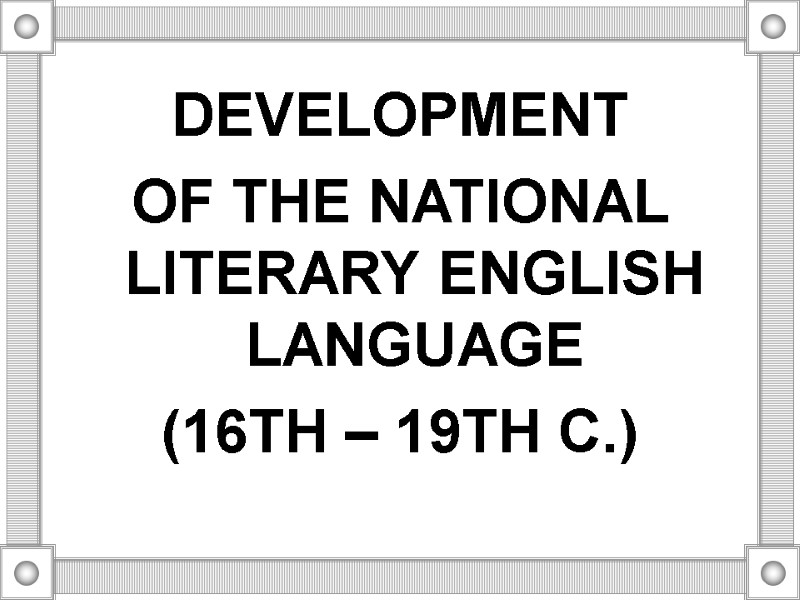
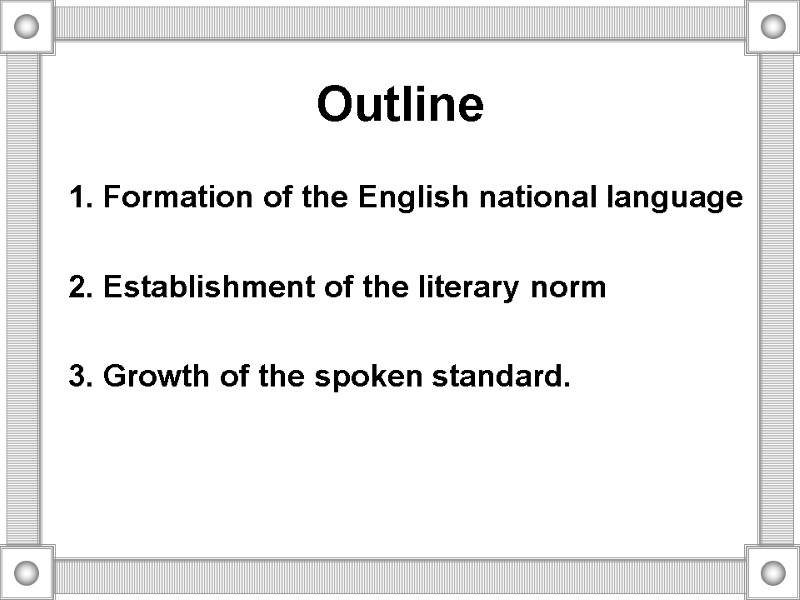
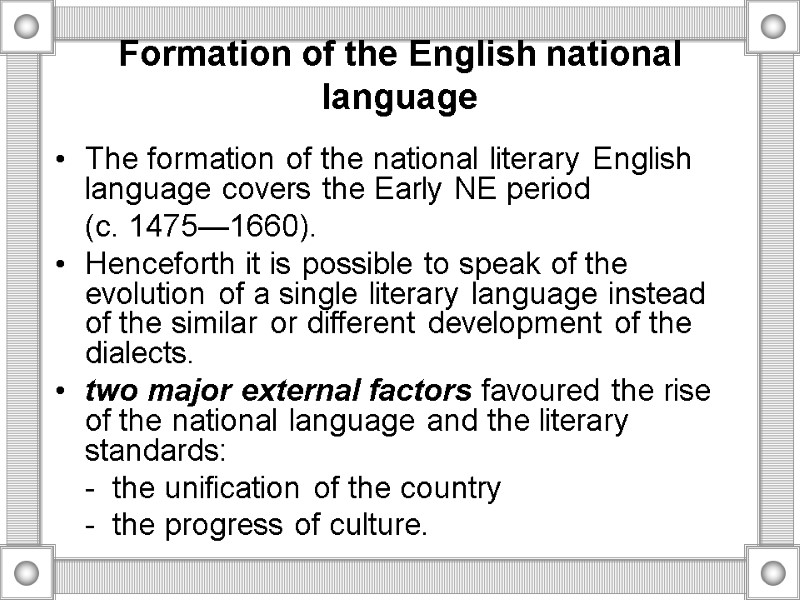
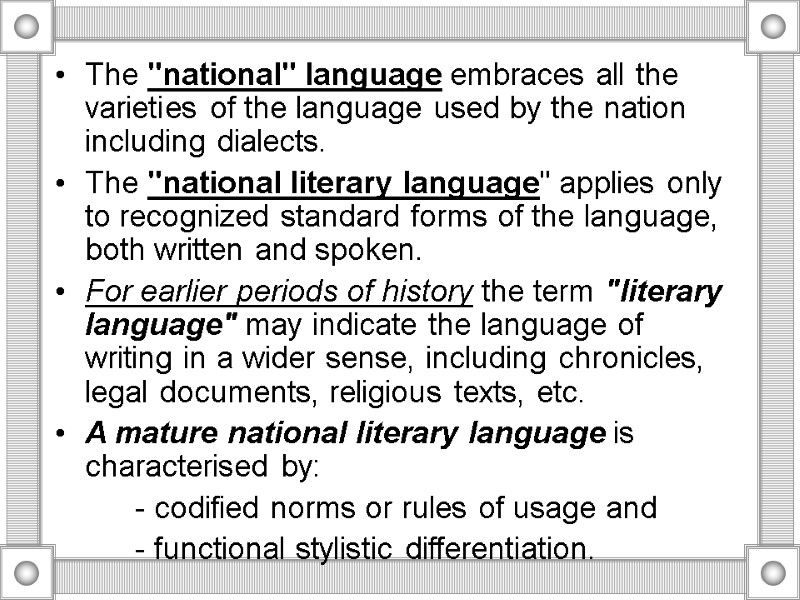
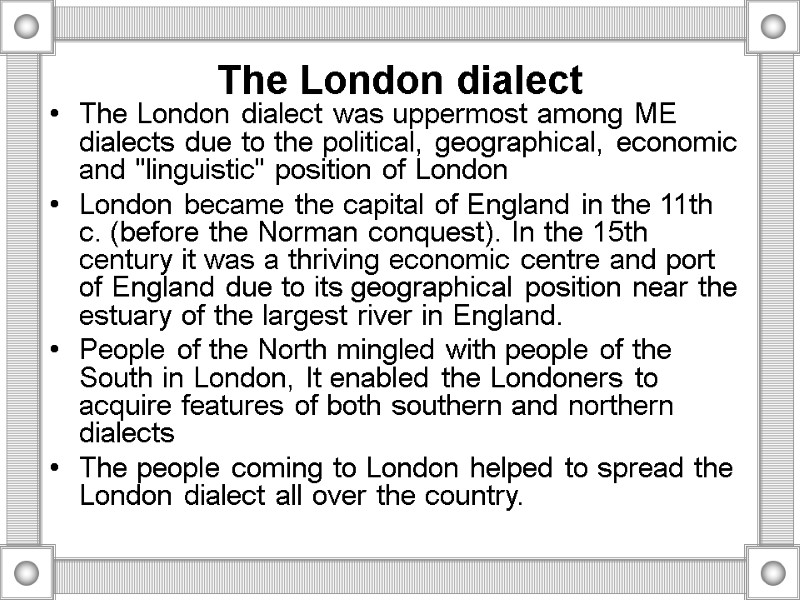
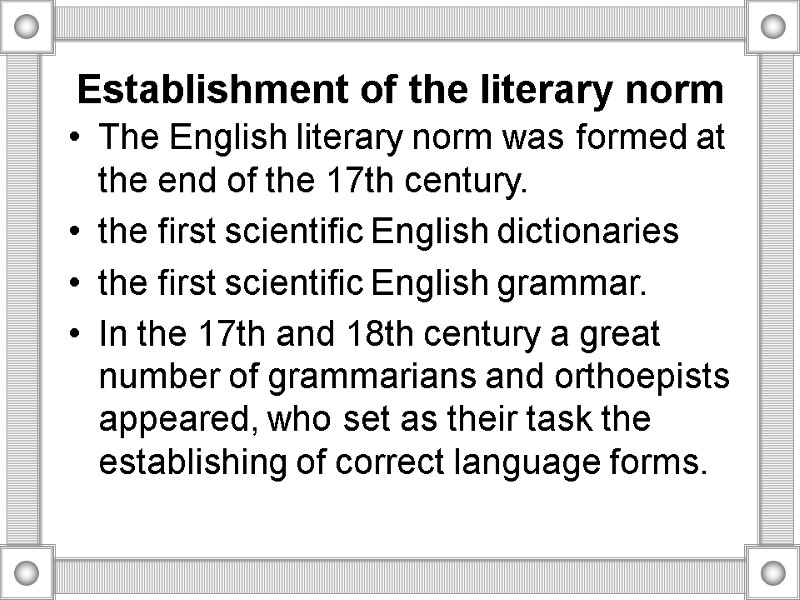
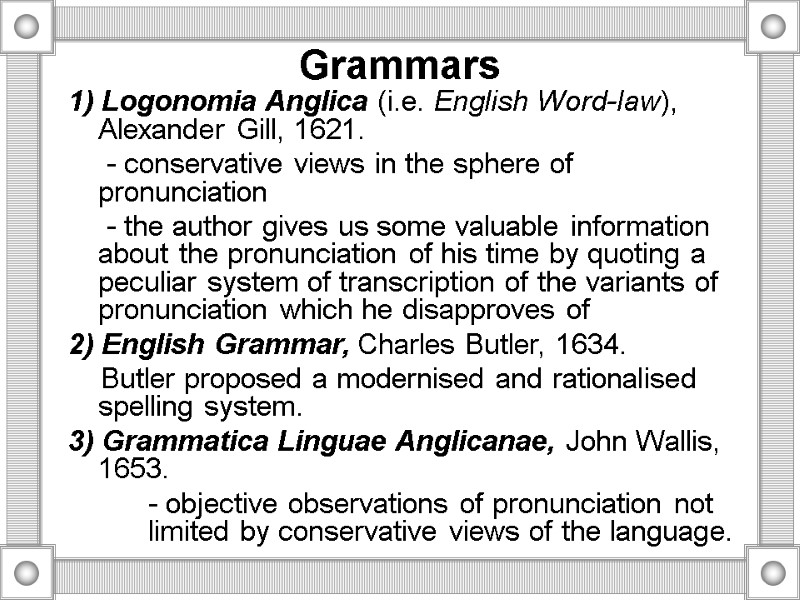
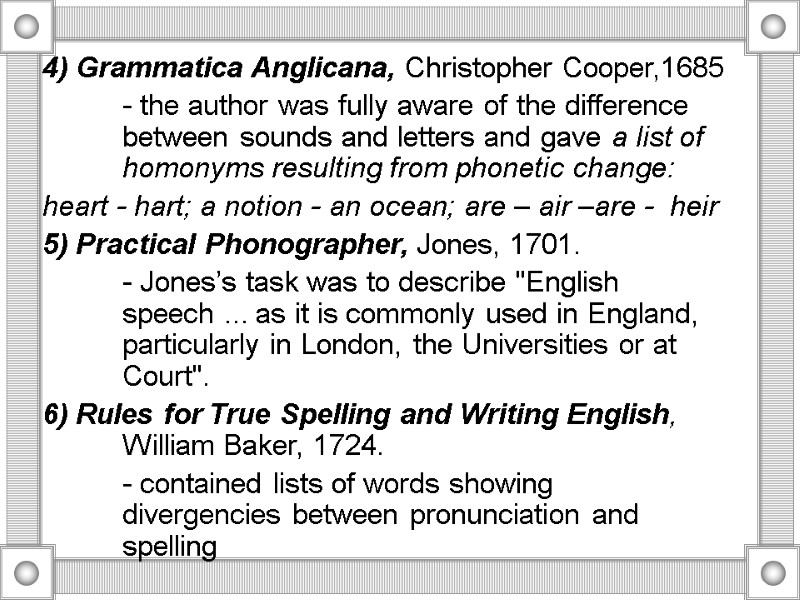
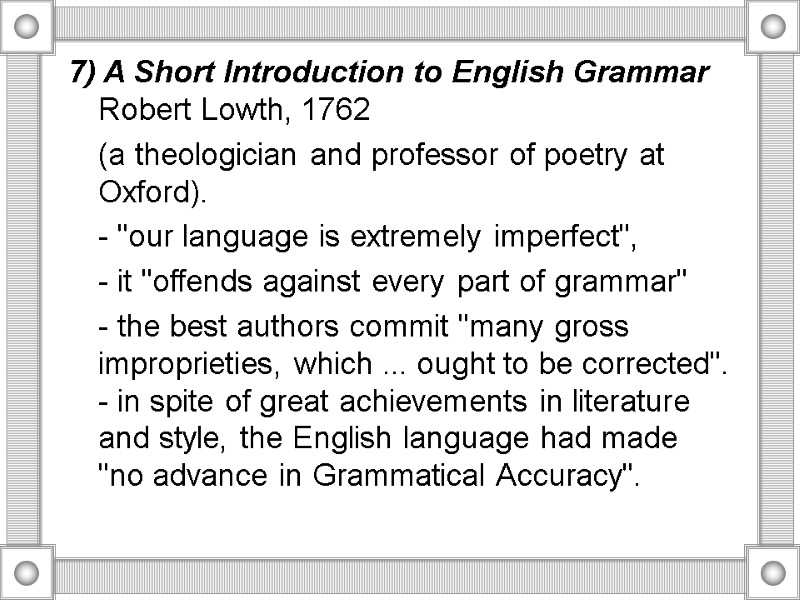
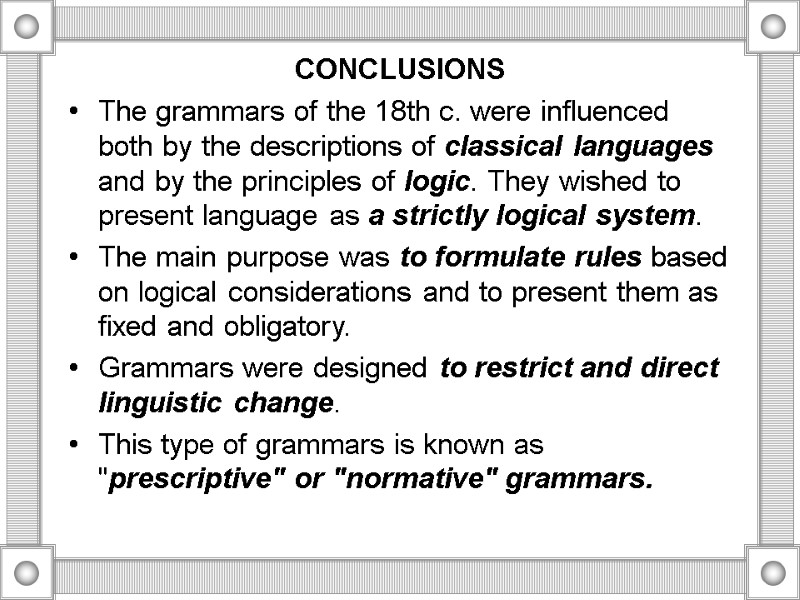
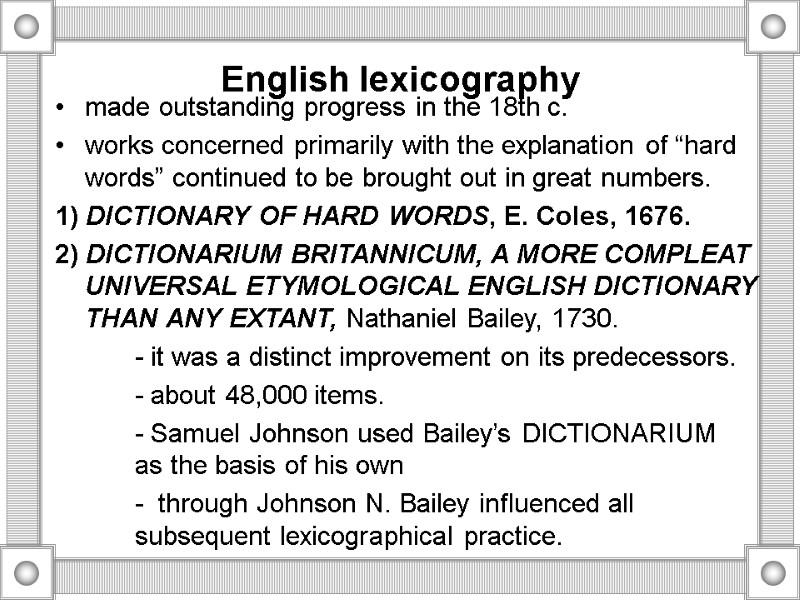
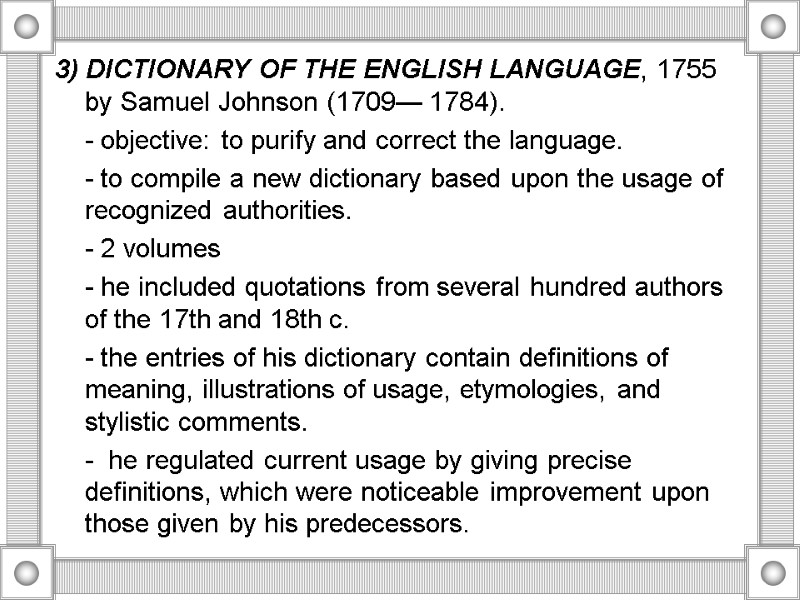
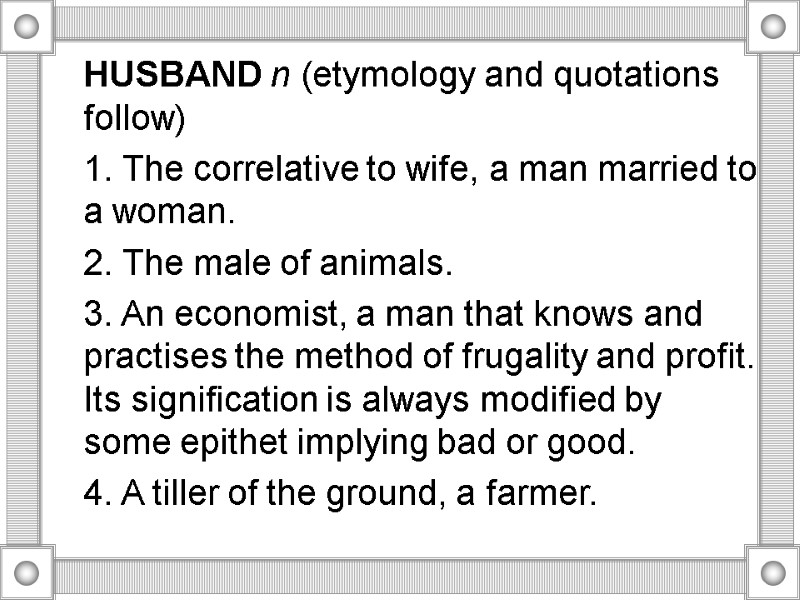
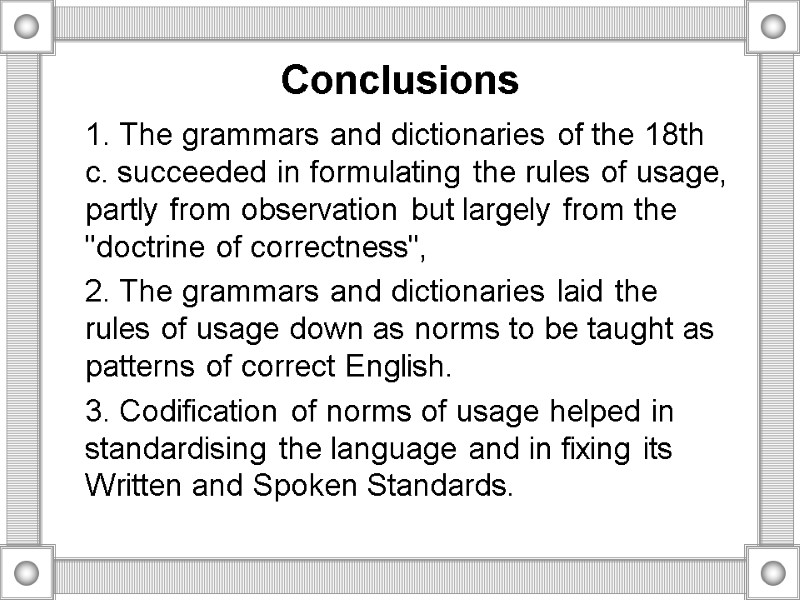
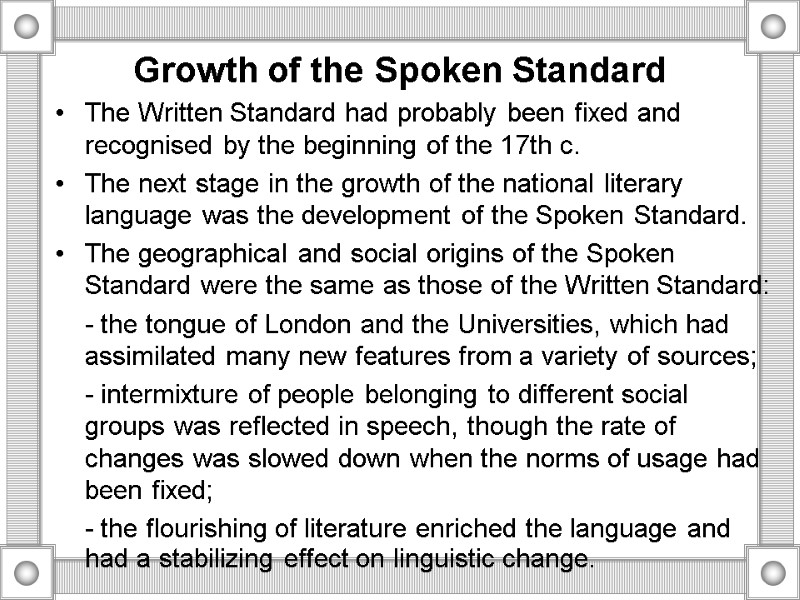
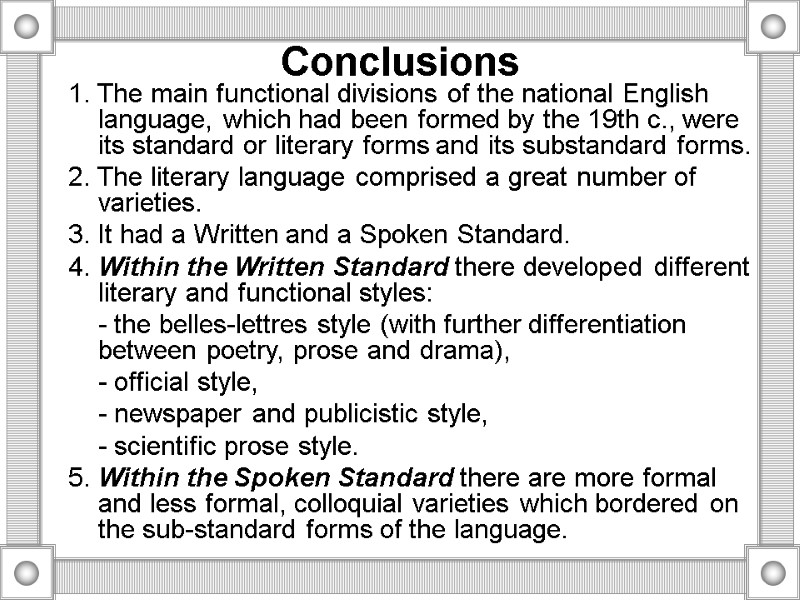
10360-development_of_the_literary_lan-ge.ppt
- Количество слайдов: 16
 DEVELOPMENT OF THE NATIONAL LITERARY ENGLISH LANGUAGE (16TH – 19TH C.)
DEVELOPMENT OF THE NATIONAL LITERARY ENGLISH LANGUAGE (16TH – 19TH C.)
 Outline 1. Formation of the English national language 2. Establishment of the literary norm 3. Growth of the spoken standard.
Outline 1. Formation of the English national language 2. Establishment of the literary norm 3. Growth of the spoken standard.
 Formation of the English national language The formation of the national literary English language covers the Early NE period (c. 1475—1660). Henceforth it is possible to speak of the evolution of a single literary language instead of the similar or different development of the dialects. two major external factors favoured the rise of the national language and the literary standards: - the unification of the country - the progress of culture.
Formation of the English national language The formation of the national literary English language covers the Early NE period (c. 1475—1660). Henceforth it is possible to speak of the evolution of a single literary language instead of the similar or different development of the dialects. two major external factors favoured the rise of the national language and the literary standards: - the unification of the country - the progress of culture.
 The "national" language embraces all the varieties of the language used by the nation including dialects. The ''national literary language" applies only to recognized standard forms of the language, both written and spoken. For earlier periods of history the term "literary language" may indicate the language of writing in a wider sense, including chronicles, legal documents, religious texts, etc. A mature national literary language is characterised by: - codified norms or rules of usage and - functional stylistic differentiation.
The "national" language embraces all the varieties of the language used by the nation including dialects. The ''national literary language" applies only to recognized standard forms of the language, both written and spoken. For earlier periods of history the term "literary language" may indicate the language of writing in a wider sense, including chronicles, legal documents, religious texts, etc. A mature national literary language is characterised by: - codified norms or rules of usage and - functional stylistic differentiation.
 The London dialect The London dialect was uppermost among ME dialects due to the political, geographical, economic and "linguistic" position of London London became the capital of England in the 11th c. (before the Norman conquest). In the 15th century it was a thriving economic centre and port of England due to its geographical position near the estuary of the largest river in England. People of the North mingled with people of the South in London, It enabled the Londoners to acquire features of both southern and northern dialects The people coming to London helped to spread the London dialect all over the country.
The London dialect The London dialect was uppermost among ME dialects due to the political, geographical, economic and "linguistic" position of London London became the capital of England in the 11th c. (before the Norman conquest). In the 15th century it was a thriving economic centre and port of England due to its geographical position near the estuary of the largest river in England. People of the North mingled with people of the South in London, It enabled the Londoners to acquire features of both southern and northern dialects The people coming to London helped to spread the London dialect all over the country.
 Establishment of the literary norm The English literary norm was formed at the end of the 17th century. the first scientific English dictionaries the first scientific English grammar. In the 17th and 18th century a great number of grammarians and orthoepists appeared, who set as their task the establishing of correct language forms.
Establishment of the literary norm The English literary norm was formed at the end of the 17th century. the first scientific English dictionaries the first scientific English grammar. In the 17th and 18th century a great number of grammarians and orthoepists appeared, who set as their task the establishing of correct language forms.
 Grammars 1) Logonomia Anglica (i.e. English Word-law), Alexander Gill, 1621. - conservative views in the sphere of pronunciation - the author gives us some valuable information about the pronunciation of his time by quoting a peculiar system of transcription of the variants of pronunciation which he disapproves of 2) English Grammar, Charles Butler, 1634. Butler proposed a modernised and rationalised spelling system. 3) Grammatica Linguae Anglicanae, John Wallis, 1653. - objective observations of pronunciation not limited by conservative views of the language.
Grammars 1) Logonomia Anglica (i.e. English Word-law), Alexander Gill, 1621. - conservative views in the sphere of pronunciation - the author gives us some valuable information about the pronunciation of his time by quoting a peculiar system of transcription of the variants of pronunciation which he disapproves of 2) English Grammar, Charles Butler, 1634. Butler proposed a modernised and rationalised spelling system. 3) Grammatica Linguae Anglicanae, John Wallis, 1653. - objective observations of pronunciation not limited by conservative views of the language.
 4) Grammatica Anglicana, Christopher Cooper,1685 - the author was fully aware of the difference between sounds and letters and gave a list of homonyms resulting from phonetic change: heart - hart; a notion - an ocean; are – air –are - heir 5) Practical Phonographer, Jones, 1701. - Jones’s task was to describe "English speech ... as it is commonly used in England, particularly in London, the Universities or at Court". 6) Rules for True Spelling and Writing English, William Baker, 1724. - contained lists of words showing divergencies between pronunciation and spelling
4) Grammatica Anglicana, Christopher Cooper,1685 - the author was fully aware of the difference between sounds and letters and gave a list of homonyms resulting from phonetic change: heart - hart; a notion - an ocean; are – air –are - heir 5) Practical Phonographer, Jones, 1701. - Jones’s task was to describe "English speech ... as it is commonly used in England, particularly in London, the Universities or at Court". 6) Rules for True Spelling and Writing English, William Baker, 1724. - contained lists of words showing divergencies between pronunciation and spelling
 7) A Short Introduction to English Grammar Robert Lowth, 1762 (a theologician and professor of poetry at Oxford). - "our language is extremely imperfect", - it "offends against every part of grammar" - the best authors commit "many gross improprieties, which ... ought to be corrected". - in spite of great achievements in literature and style, the English language had made "no advance in Grammatical Accuracy".
7) A Short Introduction to English Grammar Robert Lowth, 1762 (a theologician and professor of poetry at Oxford). - "our language is extremely imperfect", - it "offends against every part of grammar" - the best authors commit "many gross improprieties, which ... ought to be corrected". - in spite of great achievements in literature and style, the English language had made "no advance in Grammatical Accuracy".
 CONCLUSIONS The grammars of the 18th c. were influenced both by the descriptions of classical languages and by the principles of logic. They wished to present language as a strictly logical system. The main purpose was to formulate rules based on logical considerations and to present them as fixed and obligatory. Grammars were designed to restrict and direct linguistic change. This type of grammars is known as "prescriptive" or "normative" grammars.
CONCLUSIONS The grammars of the 18th c. were influenced both by the descriptions of classical languages and by the principles of logic. They wished to present language as a strictly logical system. The main purpose was to formulate rules based on logical considerations and to present them as fixed and obligatory. Grammars were designed to restrict and direct linguistic change. This type of grammars is known as "prescriptive" or "normative" grammars.
 English lexicography made outstanding progress in the 18th c. works concerned primarily with the explanation of “hard words” continued to be brought out in great numbers. 1) DICTIONARY OF HARD WORDS, E. Coles, 1676. 2) DICTIONARIUM BRITANNICUM, A MORE COMPLEAT UNIVERSAL ETYMOLOGICAL ENGLISH DICTIONARY THAN ANY EXTANT, Nathaniel Bailey, 1730. - it was a distinct improvement on its predecessors. - about 48,000 items. - Samuel Johnson used Bailey’s DICTIONARIUM as the basis of his own - through Johnson N. Bailey influenced all subsequent lexicographical practice.
English lexicography made outstanding progress in the 18th c. works concerned primarily with the explanation of “hard words” continued to be brought out in great numbers. 1) DICTIONARY OF HARD WORDS, E. Coles, 1676. 2) DICTIONARIUM BRITANNICUM, A MORE COMPLEAT UNIVERSAL ETYMOLOGICAL ENGLISH DICTIONARY THAN ANY EXTANT, Nathaniel Bailey, 1730. - it was a distinct improvement on its predecessors. - about 48,000 items. - Samuel Johnson used Bailey’s DICTIONARIUM as the basis of his own - through Johnson N. Bailey influenced all subsequent lexicographical practice.
 3) DICTIONARY OF THE ENGLISH LANGUAGE, 1755 by Samuel Johnson (1709— 1784). - objective: to purify and correct the language. - to compile a new dictionary based upon the usage of recognized authorities. - 2 volumes - he included quotations from several hundred authors of the 17th and 18th c. - the entries of his dictionary contain definitions of meaning, illustrations of usage, etymologies, and stylistic comments. - he regulated current usage by giving precise definitions, which were noticeable improvement upon those given by his predecessors.
3) DICTIONARY OF THE ENGLISH LANGUAGE, 1755 by Samuel Johnson (1709— 1784). - objective: to purify and correct the language. - to compile a new dictionary based upon the usage of recognized authorities. - 2 volumes - he included quotations from several hundred authors of the 17th and 18th c. - the entries of his dictionary contain definitions of meaning, illustrations of usage, etymologies, and stylistic comments. - he regulated current usage by giving precise definitions, which were noticeable improvement upon those given by his predecessors.
 HUSBAND n (etymology and quotations follow) 1. The correlative to wife, a man married to a woman. 2. The male of animals. 3. An economist, a man that knows and practises the method of frugality and profit. Its signification is always modified by some epithet implying bad or good. 4. A tiller of the ground, a farmer.
HUSBAND n (etymology and quotations follow) 1. The correlative to wife, a man married to a woman. 2. The male of animals. 3. An economist, a man that knows and practises the method of frugality and profit. Its signification is always modified by some epithet implying bad or good. 4. A tiller of the ground, a farmer.
 Conclusions 1. The grammars and dictionaries of the 18th c. succeeded in formulating the rules of usage, partly from observation but largely from the "doctrine of correctness", 2. The grammars and dictionaries laid the rules of usage down as norms to be taught as patterns of correct English. 3. Codification of norms of usage helped in standardising the language and in fixing its Written and Spoken Standards.
Conclusions 1. The grammars and dictionaries of the 18th c. succeeded in formulating the rules of usage, partly from observation but largely from the "doctrine of correctness", 2. The grammars and dictionaries laid the rules of usage down as norms to be taught as patterns of correct English. 3. Codification of norms of usage helped in standardising the language and in fixing its Written and Spoken Standards.
 Growth of the Spoken Standard The Written Standard had probably been fixed and recognised by the beginning of the 17th c. The next stage in the growth of the national literary language was the development of the Spoken Standard. The geographical and social origins of the Spoken Standard were the same as those of the Written Standard: - the tongue of London and the Universities, which had assimilated many new features from a variety of sources; - intermixture of people belonging to different social groups was reflected in speech, though the rate of changes was slowed down when the norms of usage had been fixed; - the flourishing of literature enriched the language and had a stabilizing effect on linguistic change.
Growth of the Spoken Standard The Written Standard had probably been fixed and recognised by the beginning of the 17th c. The next stage in the growth of the national literary language was the development of the Spoken Standard. The geographical and social origins of the Spoken Standard were the same as those of the Written Standard: - the tongue of London and the Universities, which had assimilated many new features from a variety of sources; - intermixture of people belonging to different social groups was reflected in speech, though the rate of changes was slowed down when the norms of usage had been fixed; - the flourishing of literature enriched the language and had a stabilizing effect on linguistic change.
 Conclusions 1. The main functional divisions of the national English language, which had been formed by the 19th c., were its standard or literary forms and its substandard forms. 2. The literary language comprised a great number of varieties. 3. It had a Written and a Spoken Standard. 4. Within the Written Standard there developed different literary and functional styles: - the belles-lettres style (with further differentiation between poetry, prose and drama), - official style, - newspaper and publicistic style, - scientific prose style. 5. Within the Spoken Standard there are more formal and less formal, colloquial varieties which bordered on the sub-standard forms of the language.
Conclusions 1. The main functional divisions of the national English language, which had been formed by the 19th c., were its standard or literary forms and its substandard forms. 2. The literary language comprised a great number of varieties. 3. It had a Written and a Spoken Standard. 4. Within the Written Standard there developed different literary and functional styles: - the belles-lettres style (with further differentiation between poetry, prose and drama), - official style, - newspaper and publicistic style, - scientific prose style. 5. Within the Spoken Standard there are more formal and less formal, colloquial varieties which bordered on the sub-standard forms of the language.
